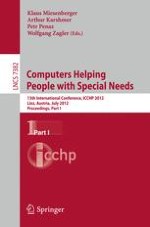The two-volume set LNCS 7382 and 7383 constiutes the refereed proceedings of the 13th International Conference on Computers Helping People with Special Needs, ICCHP 2012, held in Linz, Austria, in July 2012. The 147 revised full papers and 42 short papers were carefully reviewed and selected from 364 submissions. The papers included in the first volume are organized in the following topical sections: universal learning design; putting the disabled student in charge: user focused technology in education; access to mathematics and science; policy and service provision; creative design for inclusion, virtual user models for designing and using inclusive products; web accessibility in advanced technologies, website accessibility metrics; entertainment software accessibility; document and media accessibility; inclusion by accessible social media; a new era for document accessibility: understanding, managing and implementing the ISO standard PDF/UA; and human-computer interaction and usability for elderly.
